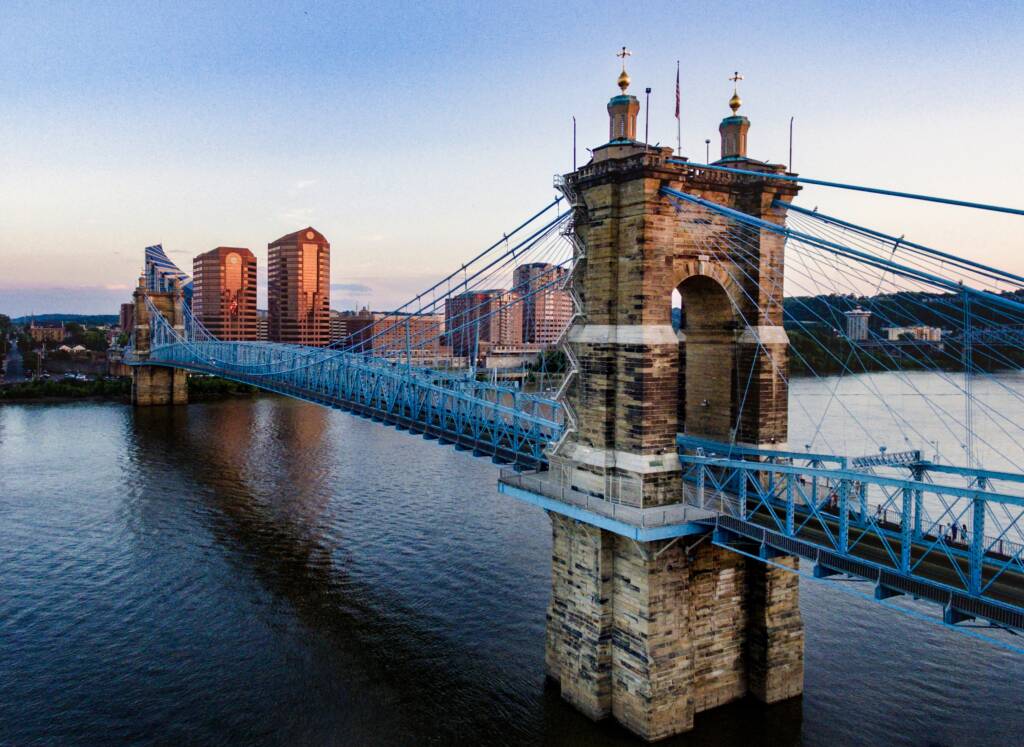The Cincinnati Roebling Suspension Bridge is a stunning feat of engineering that spans the Ohio River and connects Cincinnati, Ohio, and Covington, Kentucky. This magnificent bridge, which was completed in 1866, was once the longest suspension bridge in the world and still stands tall as an iconic landmark in the city.
In this article, we will explore the history and significance of the Cincinnati Roebling Suspension Bridge, as well as take a look at some of the neighborhoods that surround it. From the bustling city life of Downtown Cincinnati to the quaint charm of Covington, Kentucky, there is plenty to discover in this historic region.
The History and Significance of the Cincinnati Roebling Suspension Bridge
The Construction of the Bridge
Despite the challenges that arose during its construction, the Cincinnati Roebling Suspension Bridge was an impressive feat of engineering for its time. John A. Roebling’s innovative design incorporated several unique features that made the bridge both sturdy and visually stunning.
One of the key elements of the bridge’s design was its use of steel cables. Roebling was a pioneer in the use of wire rope and understood the benefits of using this material for suspension bridges. The cables used on the Cincinnati Roebling Suspension Bridge were made up of thousands of individual wires that were woven together to create a single, incredibly strong cable.
In addition to the steel cables, the bridge was also supported by two large stone towers that were anchored into the riverbed. These towers were an essential part of the bridge’s design and helped to distribute the weight of the roadway evenly across the cables.
Construction on the bridge began in 1856, but progress was slow due to a lack of funding and the outbreak of the Civil War. Work on the bridge came to a halt in 1861 when many of the workers were called away to fight in the war. However, once the war ended, construction resumed, and the bridge was finally completed in 1866.
The Cincinnati Roebling Suspension Bridge was an engineering marvel of its time and served as a model for many other suspension bridges that were built in the following years. Today, the bridge remains a testament to the skill and ingenuity of its designer and the workers who helped bring it to life. Its iconic design and rich history continue to draw visitors from all over the world who are fascinated by its beauty and significance.
The Significance of the Bridge
The Cincinnati Roebling Suspension Bridge not only played a significant role in connecting two states but also played a pivotal role in the development and progress of the city of Cincinnati. The construction of the bridge was a testament to the city’s determination to embrace modern engineering and innovation.
The bridge served as a vital link between Ohio and Kentucky, providing a convenient and efficient way for people and goods to cross the Ohio River. This connection facilitated the growth of trade and commerce in the region, enabling businesses to expand and thrive. Additionally, the bridge helped to spur the development of new residential areas on either side of the river, leading to a population boom in the surrounding neighborhoods.
The bridge’s significance was not limited to its economic impact, however. It was also a symbol of technological progress and innovation. At the time of its construction, suspension bridges were a relatively new and untested technology. The successful construction of the Cincinnati Roebling Suspension Bridge proved that suspension bridges could be a safe and efficient way to cross large bodies of water.
Today, the bridge remains an important landmark in Cincinnati and continues to play a significant role in the city’s identity. It is recognized as a National Historic Landmark and is regularly visited by tourists and locals alike. The bridge’s distinctive design and historical significance make it an enduring symbol of Cincinnati’s rich cultural heritage and ongoing commitment to progress and innovation.
Exploring the Neighborhoods around the Cincinnati Roebling Suspension Bridge
Downtown Cincinnati
Downtown Cincinnati is a bustling hub of activity that is home to a variety of restaurants, shops, and entertainment venues. Visitors can take a stroll along the riverfront or explore the numerous parks and museums that are located in the area. The Cincinnati Reds’ stadium, Great American Ballpark, is also located nearby, making it a popular destination for sports fans.
Covington, Kentucky
On the other side of the bridge, visitors will find the charming community of Covington, Kentucky. This quaint town is known for its historic architecture and unique shops and restaurants. Visitors can explore the historic MainStrasse Village or take a stroll through the lush Devou Park, which offers stunning views of the city.
Newport, Kentucky
Just a short drive from the Cincinnati Roebling Suspension Bridge, visitors will find the town of Newport, Kentucky. This community is known for its picturesque riverfront views and its array of entertainment options, including the Newport Aquarium and the Newport on the Levee shopping complex.
FAQ
Q: Is the Cincinnati Roebling Suspension Bridge open to pedestrians?
A: Yes, the Cincinnati Roebling Suspension Bridge is open to pedestrians and offers stunning views of the Ohio River and the surrounding areas.
Q: What is the best time of day to visit the Cincinnati Roebling Suspension Bridge?
A: The bridge is beautiful at any time of day, but many visitors prefer to visit at sunset when the sky is painted in vibrant shades of pink and orange.
Q: Can visitors park near the Cincinnati Roebling Suspension Bridge?
A: Yes, there are several parking garages and lots located near the bridge, as well as street parking options.
Conclusion
In conclusion, the Cincinnati Roebling Suspension Bridge is an impressive feat of engineering that has stood the test of time. Its unique design, innovative construction methods, and historical significance make it a beloved landmark in the city of Cincinnati. The bridge continues to serve as a vital link between Ohio and Kentucky, facilitating the movement of people and goods and promoting economic growth in the region.
Beyond its practical significance, the bridge is also a symbol of Cincinnati’s rich cultural heritage and ongoing commitment to progress and innovation. Its construction was a testament to the city’s determination to embrace modern engineering and push the boundaries of what was possible.
As visitors cross the Cincinnati Roebling Suspension Bridge, they are not only traversing a river but also a piece of history. The bridge remains an important part of the city’s identity and a source of pride for residents and visitors alike. It is a testament to the power of human ingenuity and the enduring legacy of those who dared to dream big and push the limits of what was possible.







1 thought on “Discovering the Beauty of Cincinnati Roebling Suspension Bridge: A Guide to Its History and Surrounding Neighborhoods”